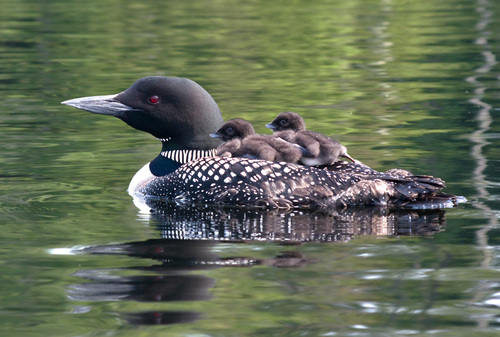
Common Loon
The Common Loon (Gavia immer) is a large, diving waterbird renowned for its haunting calls and striking black-and-white breeding plumage. It plays a crucial role in freshwater ecosystems as a top predator, primarily feeding on fish. Symbolically, the Common Loon is often associated with wilderness and solitude, featuring prominently in North American folklore and holding cultural significance for various Indigenous peoples, representing tranquility, the call of the wild, and connection to nature.
66-91 cm
Length
127-147 cm
Wingspan
Least Concern
Conservation Status
Distribution
Breeds primarily across Canada, Alaska, and the northern United States. Winters along the Pacific and Atlantic coasts of North America, as well as the coasts of Europe and Iceland. Some populations migrate across large bodies of water, while others follow coastlines.
Lifespan
Average lifespan in the wild is around 20-30 years, though some individuals can live longer.
Common Loon's Habitat
Habitat Types
Lakes, Reservoirs, Coastal waters
Climate Zones
Temperate, Boreal, Subarctic
Adaptations
Loons have dense bones (unusual for birds) that reduce buoyancy, aiding in diving. Their legs are set far back on their bodies, providing excellent underwater propulsion but making them clumsy on land. They also have specialized salt glands above their eyes to excrete excess salt when in marine environments.
Variations
While *Gavia immer* is generally considered monotypic (no recognized subspecies), some slight regional variations in size and plumage have been observed, but these are not formally classified.
Appearance
Breeding Plumage
Breeding plumage is striking, with a black head and neck, a checkered black-and-white back, and a white belly. Non-breeding plumage is much duller, with a gray-brown back and head and a white throat.
Seasonal Feather Changes
The dramatic shift between breeding and non-breeding plumage occurs during molting periods in spring and fall.
Sex Based Plumage Differences
Minimal sexual dimorphism in plumage coloration, although males are generally larger.
Notable Features
Red eyes (in breeding plumage), Sharp, pointed bill, Distinctive 'necklace' of black and white stripes on the neck (breeding plumage)
Diet and Feeding
Primary Foods
Fish, Crustaceans, Aquatic invertebrates, Amphibians
Foraging Behavior
Loons are pursuit divers, chasing prey underwater with powerful foot propulsion. They typically swallow their prey underwater, but may bring larger items to the surface.
Specializations
Their streamlined bodies and powerful legs are highly specialized for underwater pursuit. The sharp, pointed bill is ideal for grasping slippery fish.
Seasonal Diet Variations
Diet can vary depending on prey availability. In wintering areas, they may consume more crustaceans and marine invertebrates.
Behavior
Social Structure
Generally solitary or in pairs during the breeding season. They can form loose flocks during migration and in wintering areas.
Communication
Yodel (a complex, male-specific call used for territorial defense), Tremolo (a wavering call, often described as a 'laugh', used in alarm or during flight), Wail (a long, mournful call used for contact between mates or between parents and chicks), Hoot (a short, soft call used for close-range communication)
Migration
Most populations migrate to coastal waters for the winter. They typically fly at high altitudes, often at night. Migration routes can be extensive, covering thousands of kilometers.
Territorial or Group Behaviors
Highly territorial during the breeding season, defending their nesting lake from other loons. Territorial disputes can involve intense vocalizations and physical confrontations.
Conservation
Threats
Habitat loss and degradation (due to shoreline development, water pollution, and acid rain), Lead poisoning (from ingestion of lead fishing sinkers and jigs), Mercury contamination (bioaccumulation in the food chain), Oil spills, Entanglement in fishing gear, Climate change (affecting prey availability and breeding success)
Protection Programs
Monitoring programs to track population trends and assess threats, Habitat restoration and protection efforts, Regulations on the use of lead fishing tackle in some areas, Public education campaigns to raise awareness about loon conservation
Local National Laws
Protected under the Migratory Bird Treaty Act in the United States and Canada.
Population Trend
Stable
Population Estimates
The global population is estimated to be around 600,000 to 700,000 individuals.
Interesting Facts
Loons can dive to depths of up to 70 meters (230 feet) and stay underwater for several minutes.
This allows them to access a wider range of prey in deeper waters.
Loon chicks often ride on their parents' backs.
This provides protection from predators and helps the chicks conserve energy.
The Common Loon is the state bird of Minnesota.
Its iconic calls and presence on northern lakes make it a symbol of the state's wilderness.
Loons are unable to walk efficiently on land.
Their legs are positioned so far back on their body that they must slide on their bellies or push themselves along with their wings.
Faqs about Common Loon
Why do loons have red eyes?
The red eye color is thought to help with underwater vision, possibly by filtering out certain wavelengths of light.
What is the purpose of the loon's yodel?
The yodel is a complex vocalization used by male loons to advertise their territory and attract mates. Each male's yodel is unique.
How can I tell a male loon from a female loon?
It can be difficult to distinguish between male and female loons based on appearance alone. Males are generally slightly larger, but the most reliable way to tell them apart is by listening to their calls, particularly the male-specific yodel.
Are loons endangered?
The Common Loon is currently classified as Least Concern by the IUCN. However, they face a number of threats, and some local populations may be declining.
Copyright @ Nature Style Limited. All Rights Reserved.
 English
English